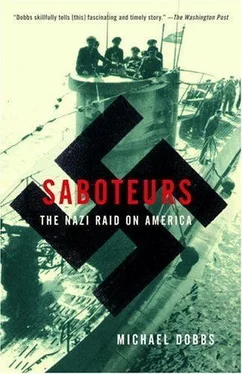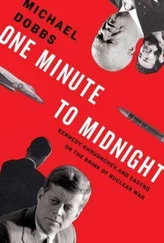“Naturally, this work is top secret,” Kappe went on, in his thickly accented version of the King’s English. “You aren’t allowed to leave the farm without permission, send mail, or receive mail. You must tell no one what you are doing here, not even your families.” 22
Kappe introduced the men to the two Abwehr specialists who would instruct them in the business of destroying factories and railroads: Herr Doktor Walter König and Herr Doktor Günther Schulz. The two Herr Doktors were both acknowledged masters of their trade, frequently called upon to display their tricks at Abwehr conferences. They had personally designed much of the sabotage equipment that the saboteurs would be taking with them to America. König’s specialty was the theory of chemical reactions; Schulz actually built the explosives.
König was “a typical Nazi type,” a tall, blond-haired man, about thirty years old, didactic and narrow-minded, with a cold stare, totally dedicated to the cause. The theme of his first lecture was how to build a simple incendiary device, using easily available materials that could be bought at a typical American drugstore without arousing suspicion. The men made detailed notes of the recipes that König scrawled on the blackboard. 23
Two hundred parts Chile saltpeter
One hundred parts sawdust
“Dampen the sawdust and mix it with the saltpeter,” König instructed. In order to light the incendiary device, they would need a rudimentary fuse. This was simple enough to create: a mixture of three parts potassium chlorate and one part powdered sugar, ignited by a drop of sulfuric acid.
König drilled the men in such basic matters as the explosive qualities of trinitrotoluene, or TNT. He showed them a block of yellow material, about the size of a brick and weighing approximately two pounds, and explained that it could be used to sever a steel rail or girder. Left by itself, the material was quite stable, he emphasized. You could fire a bullet into it, and it would disintegrate rather than explode. In order to ignite the yellow block, you needed a detonator, made up of chemicals with an explosive velocity high enough to destabilize the TNT. The detonator would in turn be linked to some kind of safety fuse and timing device, allowing a saboteur to make his getaway.
König then produced an invention that filled him with pride: a block of TNT disguised to look like a lump of coal. 24On closer examination, the trainees could see that the explosive was covered by a plastic substance of the kind one might use to repair wood, cut into an irregular shape and painted black. König showed the class a hole that had been drilled into the plastic, permitting the introduction of a detonator.
While one group was studying theory with König in the classroom, the other went next door to the laboratory to receive practical lessons from Schulz in how to assemble fuses and explosive devices. Schulz’s classes tended to be more interesting than König’s because the students got to work on their own. Smaller and more agile than König, Schulz led the morning gymnastics classes after Dempsey’s departure. He was less of a Nazi than König; there were even rumors that he had been in trouble with the Gestapo. 25
In one of his first classes, Schulz produced a test tube, some dried peas, electric wire, two screws, and two pieces of cork, and announced he would use the materials to make a simple timing device. 26First, he filled the tube halfway to the top with the peas, along with enough water to cover them. He then sliced one of the corks to make a thin disk, with a brass screw at the center, connected to a battery by electric wire. He placed the cork disk inside the test tube, so it was floating on top of the water. One-half of the circuit was now complete. He inserted the second screw into the other piece of cork, and wired it to the battery as well. He used this piece of cork to seal the top of the test tube.
The students watched, fascinated, as the dried peas slowly expanded, pushing the brass screws together and completing the electric circuit, setting off a small explosion. They spent the next lesson experimenting with test tubes of different sizes, and different quantities of water and dried peas. They discovered it was possible to delay or hasten the detonation of a bomb by playing with the different variables.
In all, the men learned to make at least ten such contraptions. Another device, for use in sabotaging railroads, consisted of a rubber ring separating two metal plates connected to a battery. Schulz showed them how to place a metal thumbtack inside the rubber ring, which could then be attached to a railroad track. When a heavy object such as a railway locomotive ran over the plates, contact would be established through the thumbtack, igniting the bomb.
During noon recess, Schulz and König took the students out to the explosives pit and mini-railroad at the end of the estate for practice in blowing things up. They explained that two pounds of the “yellow stuff” or the “black stuff” was sufficient to blow up a rail. They showed the students how to place the TNT by the side of the rail, drill a hole in it, place a detonator in the hole, and light a fuse. The first time they did this, everybody dived for cover as the device went off. When they returned to the site, they found a section of rail missing. 27As the trainees got more proficient in handling explosives and timing devices, they practiced their skills on objects scattered around the estate, such as a wooden post buried in sand or an iron bar in a cellar. They learned that it was usually unnecessary to totally destroy a target: the same result could be achieved by applying a small quantity of explosive to a critical point, causing the entire structure to collapse.
The instructors did their best to simulate the conditions that the saboteurs were likely to encounter in America by organizing mock exercises. For these exercises, the students were required to wear an outfit of black pants, black shirt, and a black cap. 28They were then divided into pairs, and given detailed instructions on what to blow up. Obstacles were placed around each target, in the form of harmless explosive devices that went off when someone approached them. Schulz and König posed as guards, leaping out from behind trees and doorways and throwing firecrackers at the nervous trainees.
BY THE end of the first week, the students had slipped into a routine. 29Reveille at seven a.m., followed by calisthenics, making of beds, and cleaning of rooms. Breakfast was at eight, classes from nine to noon. Back to the farmhouse for lunch, and an hour reading English-language newspapers and magazines. Afternoon classes ran from two to four. Then sports, consisting of soccer games, boxing instruction, discus throwing, wrestling, and occasional pistol shooting. Dinner was at six, followed by a rest period, during which the men got together with group leaders to go over what they had learned.
The classes with Schulz and König were from Monday to Thursday. On Friday, Kappe arrived from Berlin to help the men with the cover stories that they would use in America, and see how well they stood up to interrogation. The stories had to sound plausible, not only to chance acquaintances but also to the U.S. authorities: if necessary, they would be provided with false documents to back up their claims. 30As the trainee with the most extensive knowledge of America, Dasch helped Kappe drill the men in their new identities.
The trick was not to change too many personal details. That way, there would be less chance of the men becoming forgetful and giving themselves away. As far as outsiders were concerned, Dasch was now Davis. His birth date was shifted from 1903 to 1900, and his place of birth from Speyer-on-the-Rhine, Germany, to San Francisco, California. Kerling, alias Edward J. Kelly, an Irish-American bartender, also had his birthplace shifted to San Francisco. On Kappe’s instructions, Kerling added five years to his age, so that his birth date was now the spring of 1906, shortly before the Great Fire, which would conveniently explain why it was impossible to find records relating to his origins. Kappe told Dasch to look up the precise date of the fire in order to make sure the story held up.
Читать дальше












